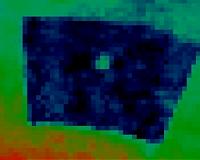 |
Gainesville FL (SPX) Sep 02, 2010 Any driver who's seen deer silhouetted by the headlights of an oncoming car knows that vital information can be conveyed by the outlines of objects. Building on this concept, University of Florida astronomers have analyzed light passing through the upper atmosphere of the giant planet HD 80606 b, about 190 light years from Earth, and determined that its atmosphere contains the element potassium. "It's wonderful that this method works so well for Jupiter-sized planets," said Knicole Colon, a UF astronomy doctoral student. "Now, we're working to apply this technique to observe smaller planets in an effort to pinpoint the components of their atmospheres." Coincidentally, another team led by David Sing at the University of Exeter, in Devon, U.K., has just used the same technique to detect potassium in the atmosphere of XO-2b, another huge planet about 485 light years from Earth. Both planets, known as gas giants, have extremely high temperatures by earthly standards - HD 80606 b reaches about 2,200 degrees Fahrenheit and XO-2b is about 1,700 degrees. That's hot enough to vaporize potassium. Together, these observations support previous computer models that predicted what the atmospheres of such planets would be like. The findings also demonstrate the value of a new observational technique that could one day aid in the characterization of planets that might support life. The observational technique is called narrow-band transit spectrophotometry, and it can measure the light absorbed by the atoms and molecules in a planet's atmosphere, said Eric Ford, a UF astronomy associate professor and Colon's adviser. "This new technique only works for planets that pass in front of their parent stars as viewed from Earth. Most of the nearly 500 known planets do not, and even fewer orbit stars that are bright enough for such precise observations," Ford said. "Another challenge is that observations must be carefully timed, in order to see the planets in silhouette against the backlighting of their parent star." Transit spectrophotometry works like this: While the planet is backlit, astronomers measure the light that passed through its atmosphere. Atoms and molecules absorb specific wavelengths (colors) of light, providing a chemical signature that scientists can recognize. By analyzing the amount of absorption by the planet's atmosphere at specific wavelengths, astronomers can detect the presence of a particular atom or molecule - in this case, potassium. The UF team - Colon and Ford, along with colleagues from the University of California, Santa Cruz, Penn State University, Wesleyan University and the Universidad de La Laguna in Tenerife, Spain - had help from another technological breakthrough. These researchers, as well as the Exeter team, used one of the world's most powerful telescopes, the Gran Telescopio Canarias. The observatory includes a mirror almost 35 feet wide and is situated at one of the world's best locations for star-gazing, in the Canary Islands off the northwest coast of Africa. UF is a 5 percent partner in the enormous telescope, that captures enough light to make transit spectrophotometry possible, Colon said. Sing says he's excited about future prospects for transit spectrophotometry. "The initial results from both teams have been very encouraging," Sing said. "We still haven't explored the full capabilities or ultimate limitations of the instrument yet." In 2002, the Hubble Space Telescope detected a similar element, sodium, in the atmosphere of the gas giant planet HD 209458 b. Since then, astronomers have detected sodium in only one other planet. Colon plans to search for potassium in the atmospheres of additional giant planets to learn about the diversity of planetary atmospheres. She hopes that planet searches such as NASA's Kepler Mission will identify many more planets that cross the faces of their parent stars. "The Kepler Mission has the precision to find even more planets, including some as small as the Earth," she said. Ultimately, Ford and Colon want to examine smaller, Earth-like planets for molecules such as methane gas and water vapor, as both are intimately linked to life on Earth.
Share This Article With Planet Earth
Related Links University of Florida Lands Beyond Beyond - extra solar planets - news and science Life Beyond Earth
 A Dusty, Cloudy Exoplanet
A Dusty, Cloudy ExoplanetMoffett Field CA (SPX) Sep 02, 2010 Astronomers at the University of Hawaii have measured the temperature of a young gas-giant planet around another star using the W. M. Keck Observatory, and the results are puzzling. They have found that its atmosphere is unlike that of any previously studied extrasolar planet. By obtaining a spectrum of its emitted light, the astronomers determined the temperature of the planet. As a resul ... read more |
|
| The content herein, unless otherwise known to be public domain, are Copyright 1995-2010 - SpaceDaily. AFP and UPI Wire Stories are copyright Agence France-Presse and United Press International. ESA Portal Reports are copyright European Space Agency. All NASA sourced material is public domain. Additional copyrights may apply in whole or part to other bona fide parties. Advertising does not imply endorsement,agreement or approval of any opinions, statements or information provided by SpaceDaily on any Web page published or hosted by SpaceDaily. Privacy Statement |